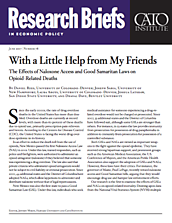In an effort to reduce the death toll from the use of opioids, New Mexico passed the first Naloxone Access Law (NAL) in 2001. Under this law, trained responders, such as police and firefighters, were authorized to administer an opioid antagonist (naloxone) if they believed that someone was experiencing a drug overdose. The law also said that private citizens who administer opioid antagonists would not be subject to civil liability or criminal prosecution. Since 2001, 44 additional states and the District of Columbia have adopted NALs, which allow laypersons to administer and distribute naloxone without fear of legal repercussions. New Mexico was also the first state to pass a Good Samaritan Law (GSL). Under this law, individuals who seek medical assistance for someone experiencing a drug-related overdose would not be charged or prosecuted. Since 2007, 33 additional states and the District of Columbia have followed suit, although some GSLs are stronger than others. For instance, in 23 states the law provides immunity from prosecution for possession of drug paraphernalia in addition to immunity from prosecution for possession of a controlled substance.
With a Little Help from My Friends: The Effects of Naloxone Access and Good Samaritan Laws on Opioid-Related Deaths
Since the early 2000s, the rate of drug overdose deaths in the United States has more than doubled. Overdose deaths are currently at record levels, with more than 60 percent of these deaths due to opioid use, primarily prescription pain relievers and heroin. According to the Centers for Disease Control (CDC), the United States is facing the worst drug overdose epidemic in its history.
Both GSLs and NALs are viewed as important weapons in the fight against the opioid epidemic. They have received strong bipartisan support, and prominent groups such as the American Medical Association, the U.S. Conference of Mayors, and the American Public Health Association also support the adoption of GSLs and NALs. However, these laws have their critics. For instance, the governor of Maine, Paul LePage, recently vetoed naloxone access and Good Samaritan bills, arguing that they would encourage drug use and hamper law enforcement efforts.
Our research is the first to examine the effects of GSLs and NALs on opioid-related mortality. Drawing upon data from the National Vital Statistics System (NVSS) multiple cause-of-death mortality files for the period 1999–2014, we estimate standard difference-in-difference models, which exploit within-state variation and control flexibly for common shocks caused by, for instance, the reformulation of OxyContin in 2010.
We find that the adoption of an NAL is associated with a 9 to 11 percent reduction in opioid-related deaths. The relationship between NALs and opioid-related deaths that do not involve heroin appears to be stronger than the relationship between NALs and heroin-related deaths. Moreover, our results suggest that removing criminal liability for possession of naloxone is an important feature of these laws. Removing criminal liability for possession of naloxone is associated with a 13 percent reduction in opioid-related deaths, while estimates of the effect of NALs without this provision are considerably smaller and statistically indistinguishable from zero. The estimated effects of GSLs on opioid-related deaths are consistently negative, but not statistically significant at conventional levels. We do, however, find stronger evidence that GSLs reduce opioid-related deaths involving alcohol. Finally, contrary to the claims made by some critics of NALs and GSLs, we find little evidence that these laws increase the recreational use of prescription painkillers.
NOTE:
This research brief is based on Daniel Rees, Joseph Sabia, Laura Argys, Joshua Latshaw, and Dhaval Dave, “With a Little Help from My Friends: The Effects of Naloxone Access and Good Samaritan Laws on Opioid-Related Deaths,” February 2017, http://www.nber.org/papers/w23171.
